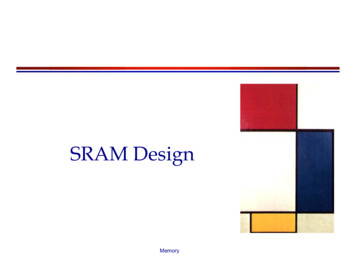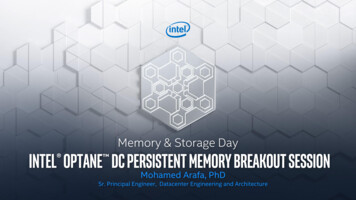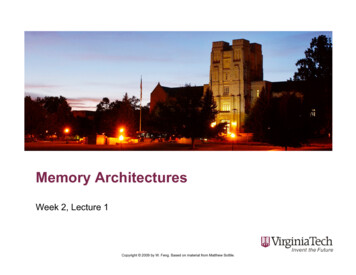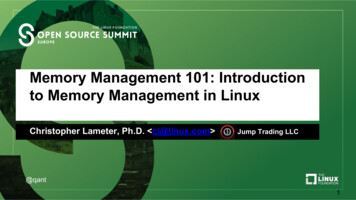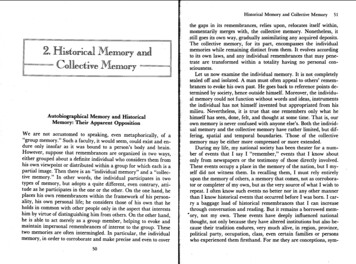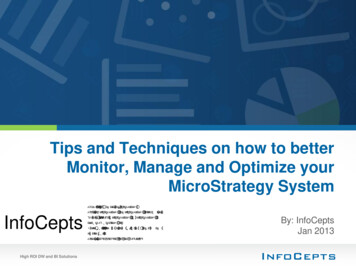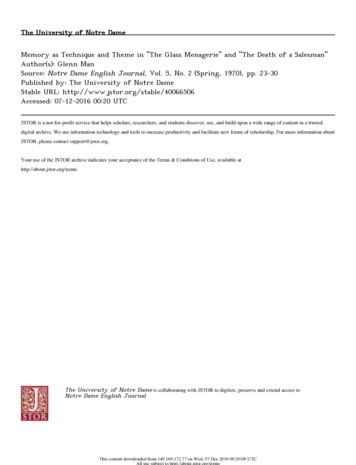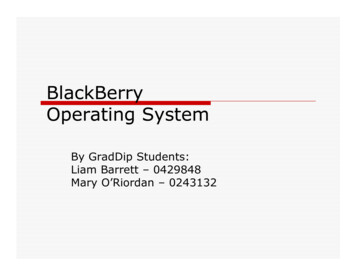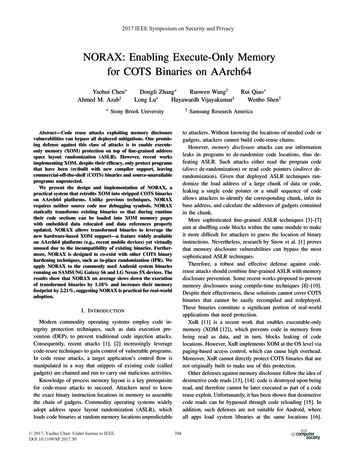
Transcription
2017 IEEE Symposium on Security and PrivacyNORAX: Enabling Execute-Only Memoryfor COTS Binaries on AArch64Yaohui Chen Ahmed M. Azab† Dongli Zhang Ruowen Wang† Long LuHayawardh Vijayakumar††Stony Brook UniversitySamsung Research Americato attackers. Without knowing the locations of needed code orgadgets, attackers cannot build code-reuse chains.However, memory disclosure attacks can use informationleaks in programs to de-randomize code locations, thus defeating ASLR. Such attacks either read the program code(direct de-randomization) or read code pointers (indirect derandomization). Given that deployed ASLR techniques randomize the load address of a large chunk of data or code,leaking a single code pointer or a small sequence of codeallows attackers to identify the corresponding chunk, infer itsbase address, and calculate the addresses of gadgets containedin the chunk.More sophisticated fine-grained ASLR techniques [3]–[7]aim at shuffling code blocks within the same module to makeit more difficult for attackers to guess the location of binaryinstructions. Nevertheless, research by Snow et al. [1] provesthat memory disclosure vulnerabilities can bypass the mostsophisticated ASLR techniques.Therefore, a robust and effective defense against codereuse attacks should combine fine-grained ASLR with memorydisclosure prevention. Some recent works proposed to preventmemory disclosures using compile-time techniques [8]–[10].Despite their effectiveness, these solutions cannot cover COTSbinaries that cannot be easily recompiled and redeployed.These binaries constitute a significant portion of real-worldapplications that need protection.XnR [11] is a recent work that enables executable-onlymemory (XOM [12]), which prevents code in memory frombeing read as data, and in turn, blocks leaking of codelocations. However, XnR implements XOM at the OS level viapaging-based access control, which can cause high overhead.Moreover, XnR cannot directly protect COTS binaries that arenot originally built to make use of this protection.Other defenses against memory disclosure follow the idea ofdestructive code reads [13], [14]: code is destroyed upon beingread, and therefore cannot be later executed as part of a codereuse exploit. Unfortunately, it has been shown that destructivecode reads can be bypassed through code reloading [15]. Inaddition, such defenses are not suitable for Android, whereall apps load system libraries at the same locations [16].Abstract—Code reuse attacks exploiting memory disclosurevulnerabilities can bypass all deployed mitigations. One promising defense against this class of attacks is to enable executeonly memory (XOM) protection on top of fine-grained addressspace layout randomization (ASLR). However, recent worksimplementing XOM, despite their efficacy, only protect programsthat have been (re)built with new compiler support, leavingcommercial-off-the-shelf (COTS) binaries and source-unavailableprograms unprotected.We present the design and implementation of NORAX, apractical system that retrofits XOM into stripped COTS binarieson AArch64 platforms. Unlike previous techniques, NORAXrequires neither source code nor debugging symbols. NORAXstatically transforms existing binaries so that during runtimetheir code sections can be loaded into XOM memory pageswith embedded data relocated and data references properlyupdated. NORAX allows transformed binaries to leverage thenew hardware-based XOM support—a feature widely availableon AArch64 platforms (e.g., recent mobile devices) yet virtuallyunused due to the incompatibility of existing binaries. Furthermore, NORAX is designed to co-exist with other COTS binaryhardening techniques, such as in-place randomization (IPR). Weapply NORAX to the commonly used Android system binariesrunning on SAMSUNG Galaxy S6 and LG Nexus 5X devices. Theresults show that NORAX on average slows down the executionof transformed binaries by 1.18% and increases their memoryfootprint by 2.21%, suggesting NORAX is practical for real-worldadoption.I. I NTRODUCTIONModern commodity operating systems employ code integrity protection techniques, such as data execution prevention (DEP), to prevent traditional code injection attacks.Consequently, recent attacks [1], [2] increasingly leveragecode-reuse techniques to gain control of vulnerable programs.In code reuse attacks, a target application’s control flow ismanipulated in a way that snippets of existing code (calledgadgets) are chained and run to carry out malicious activities.Knowledge of process memory layout is a key prerequisitefor code-reuse attacks to succeed. Attackers need to knowthe exact binary instruction locations in memory to assemblethe chain of gadgets. Commodity operating systems widelyadopt address space layout randomization (ASLR), whichloads code binaries at random memory locations unpredictable 2017, Yaohui Chen. Under license to IEEE.DOI 10.1109/SP.2017.30Rui Qiao Wenbo Shen†304
Therefore, a memory read in one app enables code reuseattacks in any other app.In this work, we propose N ORAX 1 , which protects COTSbinaries from code memory disclosure attacks. N ORAX allowCOTS binaries to be loaded in hardware-enforced XOM,a security feature supported by recent ARM CPUs (i.e.,AArch64). Such CPUs are widely seen on today’s mobiledevices. Without N ORAX, to use the XOM feature, binariesneed to be (re)built with the necessary compiler support. Thisrequirement stands in between the valuable security featureand a large number of COTS binaries (e.g., all Android systemexecutables and libraries) that are already running on AArch64CPUs but were not compiled with XOM support. N ORAXremoves this requirement. It automatically patches existing binaries and loads their code to XOM-enforced memory regions,without affecting binaries’ normal execution. As a result,binaries without special (re)compilation can benefit from thehardware-backed XOM feature and be protected against codememory disclosure. Further, when used together with ASLR,N ORAX enables robust mitigation against code reuse attacksfor COTS binaries. It is worth noting that we use Android asthe reference platform for building and evaluating N ORAX.However, N ORAX’s approach and techniques are generallyapplicable to other AArch64 platforms.N ORAX consists of four major components: NDisassembler, NPatcher, NLoader, and NMonitor. The first two performoffline binary analysis and transformation. They convert anyCOTS binary built for AArch64 without XOM support intoone whose code can be protected by XOM during runtime.The other two components provide supports for loading andmonitoring the patched, XOM-enabled binaries during runtime. The design of N ORAX tackles a fundamentally difficultproblem: identifying data embedded in code segments, whichare common in ARM binaries, and relocating such dataelsewhere so that during runtime code memory pages can bemade executable-only while allowing all embedded data to bereadable.As a evaluation, we apply N ORAX to Android systembinaries running on SAMSUNG Galaxy S6 and LG Nexus5X devices. The results show that N ORAX on average slowsdown the transformed binaries by 1.18% and increases theirmemory footprint by 2.21%, suggesting N ORAX is practicalfor real-world adoption.In summary, our work makes the following contributions: The rest of the paper is organized as follows: In § II welay out the background for execute-only memory and explainthe code-data separation challenges tackled by N ORAX; In§ III we derive the requirements for a practical solution andthen present the design of our system; In § IV we discuss indetails the system implementation and the optimization for ourreference platform Android; We then examine the correctnessof N ORAX and evaluate its performance in § V. We contrastthe related works in § VI and analyze the compatibility ofN ORAX with other COTS hardening techniques and its currentlimitations in § VII. We conclude the paper in § VIII.II. BACKGROUNDN ORAX makes use of the modern MMU support inAArch64 architecture to create execute-only memory, whichis a hardware feature now widely available yet virtuallyunused due to compatibility issues. To bridge the gap, N ORAXreconstructs COTS binaries running on commodity Androidsmartphones to enforce the R X policy. In the rest of thissection, we explain the necessary technical background andthe challenges we face when building the system.AArch64 eXecute-Only Memory (XOM) Support: AArch64defines four Exception Levels, from EL0 to EL3. EL0 has thelowest execution privilege, usually runs normal user applications; EL1 is usually for hosting privileged systems, such asoperating system kernel; EL2 is designed for hypervisor whileEL3 is for secure monitor.In order to enforce the instruction access permission for different Exception Levels, AArch64 leverages the UnprivilegedeXecute Never (UXN) bit, Privileged eXecute-Never (PXN)bit and two AP (Access Permission) bits defined in the pagetable entry [17]. For the user space program code page, theUXN bit is set to “0”, which allows the code execution atEL0, while PXN is set to “1”, which disables the executionin EL1. With such UXN and PXN settings, the instructionaccess permissions defined by AP bits are shown in Table I.It is easy to see that we can set the AP bits in page tableentry to “10”, so that the kernel running in EL1 will enforcethe execute-only permission for user space program, which isrunning in EL0. In other words, the corresponding memorypage will only permit for instruction fetch for user spaceprogram, while all read/write data accesses will be denied.We discover and address the gap between the highlyvaluable XOM feature and existing binaries, which needbut cannot use the feature without recompilation.We design and implement a comprehensive system thatconverts COTS binaries to be XOM-compatible without1 N ORAXrequiring source code or debugging symbols.We show that code-data separation problem, althoughundecidable in principle, is in practice achievable onAArch64 platforms using our novel embedded data detection algorithm.We perform rigorous and extensive evaluations withstripped system executables and libraries on Android andshow that N ORAX is practical, effective and efficient.stands for NO Read And eXecute.305
TABLE I: Access permissions for stage 1 EL0 and EL1AP[2:1]00011011EL0 PermissionExecutable-onlyRead/Write, Config-ExecutableExecutable-onlyRead, ExecutableEL1 wever, the kernel still has the read permission to that page,which means that it can help the user space program readthe intended memory area if necessary, but need to performsecurity checks beforehand.Position-Independent Binaries in Android: Positionindependent code (PIC) is the kind of code compiler generatesfor a module that does not assume any absolute address, thatis, no matter where the module is loaded, it will be ableto function correctly. The mechanism works by replacing allthe memory accesses using hard-coded addresses with PCrelative addressing instructions. Position-independent executables (PIE) are executables that employ PIC code. In Android,ever since version 5 (codename: Lolipop), in order to fullyenjoy the benefit of ASLR, all the executables are requiredto be compiled as PIE. To enforce this, Google removed thesupport for non-PIE loading from the Bionic Linker [18].Nowadays, smartphones equipped with AArch64 CPU aremost likely running Android OSes after Lolipop, meaningthe majority of them will only have binaries, including bothexecutables and shared libraries, that are compiled to beposition independent. Code-Data Separation: To convert a stripped binary to beXOM-compatible, there is one fundamental problem to solve,namely code-data separation. Note that separating data fromcode for COTS binaries is, in general, undecidable as it isequivalent to the famous Halting Problem [19]. But we foundthat in the scope of ARM64 position-independent binaries,which are prevalent in modern Android and iOS [20] Phones,a practical solution is possible. Basically, a feasible solutionshould address the two following challenges.1) Locating Data In Code Pages: We generally refer to dataresiding in executable code regions as executable data. Thereare two types of executable data allowed in ELF binaries. Executable sections: The first kind of data are those ELFsections consisting of pure read-only data which couldreside in executable memory. Defined by contemporaryELF standard, a typical ELF file has two views: linkingview and loading view, used by linker and loader respectively. Linking view consists of ELF sections (such as.text, .rodata). During linking, the static linker bundlesthose sections with compatible access permissions toform a segment – in this case, executable indicates readable. The segments then comprise the loading view. Whenan ELF is being loaded, the loader simply loads eachof the segments as a whole into memory, and grant thecorresponding access permissions. A standard ELF hastwo loadable segments. One is readable and executable,which is normally referred as “code segment”. Thissegment contains all the sections with instructions (.pltand .text, etc.), and read-only data (.gnu.hash, .dynsym,etc.); the other segment is readable and writable, referredas “data segment”, it contains the program data as well asother read/writ-able sections. For our goal to realize nonreadable code, we mainly focus on the code segment.In this segment, generally only .plt and .text containinstructions used for program execution, but as explainedbefore, they are mixed with other sections that onlyneed to be read-only, thus we cannot simply map thememory page to execute-only as oftentimes these sectionscould locate within the same page. For instance, Table IIshows the code segment layout of an example program,all except the last two sections in this code segmentare placed within the same page. To make things morecomplex, the segment layout varies for different ELFs.Embedded data: The second kind of data in the codepages is those embedded data in the .text section. Foroptimization purpose, such as exploiting spatial locality,compilers emit data to places nearby their accessing code.Note that albeit recent study [21] shows that in modernx86 Linux, compilers no longer generate binaries thathave code interleaved with data, to the opposite of ourdiscovery, we found this is not the case for ARM, weexamined the system binaries extracted from smartphoneNexus 5X running the factory image MMB29P, Table IIIreveals that code-data interleaving still prevails in thosemodern ARM64 Linux binaries, indicating this is a realworld problem to be solved.TABLE II: ELF sections that comprise the code segment ofthe example program, the highlighted ones are locate in thesame page.Section nu.hash.dynsym.dynstr.gnu.version.gnu.version r.rela.dyn.rela.plt.plt.text.rodata.eh frame hdr.eh 01110TypePROGBITSNOTENOTEGNU ITSPROGBITSPROGBITSPROGBITS
disclosure attacks. While we demonstrate N ORAX on Android,the ideas behind N ORAX are generally applicable to anyAAarch64 platform.TABLE III: Android Marshmallow system binaries that haveembedded data in Nexus 5X. Design Principles: To make N ORAX widely useful in practice,we set the following design principles for N ORAX: 2) Updating Data References: In addition to finding out thelocations of executable data, we also need to relocate them andupdate their references. It turns out that references updatingis also non-trivial. In our system, as shown in Table IV,the majority of the ELF sections inside code segment areexpected to be relocated to a different memory location so thatappropriate permission can be enforced. The sections that areleft out, such as .interp and .note. are either accessed onlyby OS or not used for program execution so we can leavethem untouched. For those sections listed in Table IV, theyhave complex interconnections, both internally and externally.As shown in Table V, various types of references exist in agiven ELF. Due to this complexity, the references collectionis conducted across the whole N ORAX system by differentcomponents in different stages including both offline andduring load-time. TABLE IV: Sections in the executable code page that arehandled by N ORAX(.gnu).hash.rela.plt.dynsym.text (embedded data).dynstr.rodata.gnu.version.eh frame.rela.dyn.eh frame hdrNORAX Workflow: N ORAX consists of four major components: NDisassembler, NPatcher, NLoader, and NMonitor, asshown in Figure 1. The first two components perform offlinebinary analysis and transformation and the last two provideruntime support for loading and monitoring the patched,XOM-compatible executables and libraries. In addition todisassembling machine code, NDisassembler scans for allexecutable code that needs to be protected by XOM. A majorchallenge it solves is identifying various types of data thatARM compilers often embed in the code section, includingjump tables, literals, and padding. Unlike typical disassemblers, NDisassembler has to precisely differentiate embeddeddata from code in order to achieve P 2 and P 3 (§III-B). Takinginput from NDisassembler, NPatcher transforms the binary sothat its embedded data are moved out of code sections andtheir references are collected for later adjustment. After thetransformation, NPatcher inserts a unique magic number in thebinary so that it can be recognized by NLoader during loadtime. NPatcher also stores N ORAX metadata in the binary,which will be used by NLoader and NMonitor (§III-C). Whena patched binary is being loaded, NLoader takes over theloading process to (i) load the N ORAX metadata into memory,TABLE V: ELF section reference typesReference TypeIntra-section referencesInter-section referencesExternal referencesMultiple external referencesP1 - Backward compatibility: Changes introduced byN ORAX to binaries must not break their standard structures or compilation conventions (i.e., patched binariescan run on devices without N ORAX support). Otherwise,patched binaries may become incompatible with existingloaders, linkers, or orthogonal binary-hardening solutions(e.g., code diversification techniques). Furthermore, N O RAX must not make special assumptions about binariesto facilitate analysis and patching.P2 - Completeness: N ORAX must have complete coverage of embedded data. It must detect all embedded data ina binary accessed by code and ensure that these accessesstill succeed when XOM enforcement is in place. On theother hand, N ORAX can only have very few, if not zero,false positives (i.e., misidentifying code as data).P3 - Correctness: N ORAX must not alter or break apatched binary’s original function or behavior, needlessto say crashing the binary.P4 - Low Overhead: N ORAX should not introduce impractical overheads to the patched binaries, including bothspace overhead (e.g., binary sizes and memory footprint)and runtime slowdown.Example.text refers to .text (embedded data).text refers to .rodatadynamic linker refers to .dynsym, .rela. C runtime/debugger refer to .eh frameIII. N ORAX D ESIGNA. System OverviewThe goal of N ORAX is to allow COTS binaries to takeadvantage of execute-only memory (XOM), a new securityfeature that recent AArch64 CPUs provide and is widely available on today’s mobile devices. While useful for preventingmemory disclosure-based code reuse [1], [2], XOM remainsbarely used by user and system binaries due to its requirement for recompilation. N ORAX removes this requirementby automatically patching COTS binaries and loading theircode to XOM. As a result, existing binaries can benefit romthe hardware-backed protection against direct code memory307
Fig. 1: NORAX System Overview: the offline tools (left) analyze the input binary, locate all the executable data and theirreferences (when available), and then statically patch the metadata to the raw ELF; the runtime components (right) createseparated mapping for the executable data sections and update the recorded references as well as those generated at runtime.(ii) adjust the NPatcher-collected references as well as thosedynamically created references to the linker-related sections(e.g .hash, .rela.*), and (iii) map all memory pages thatcontain code to XOM (§III-D). During runtime, NMonitor,an OS extension, handles read accesses to XOM. While suchaccesses are rare and may indicate attacks, they could also belegitimate because NPatcher may not be able to completelyrecognize dynamic references to the relocated embedded data(e.g., those generated at runtime). When there are missed datareferences, the access will trigger an XOM violation, whichNMonitor verifies and, if legitimate, facilitates the access tothe corresponding data (§III-E). NDisassembler uses Algorithm 1 to construct an initial setof embedded data (IS) and a set of reference sites (RS).For embedded data whose size cannot be precisely bounded,NDisassembler collects their seed addresses (AS) for furtherprocessing. As shown in Line 5–9 in Algorithm 1, sincethe load size for ldr-literal instructions is known, theidentified embedded data are added to IS. On the other hand,the handling for adr instructions is more involved, as shownin Line 10–27. NDisassembler first performs forward slicingon xn — the register which holds the embedded data address.All instructions that have data dependencies on xn are sliced,and xn is considered escaped if any of its data-dependentregisters is either (i) stored to memory or (ii) passed to anotherfunction before being killed. In either case, the slicing alsostops. If not all memory dereferences based on xn can beidentified due to reference escaping, the size of the embeddeddata cannot be determined. Therefore, NDisassembler onlyadds the initial value of xn to AS, as a seed address (Line24–26).B. NDisassembler: Static Binary AnalyzerNDisassembler first converts an input binary from machinecode to assembly code and then performs analysis neededfor converting the binary into an XOM-compatible form. Itdisassembles the binary in a linear sweep fashion, whichyields a larger code coverage than recursive disassembling[21]. However, the larger code coverage comes at a costof potentially mis-detecting embedded data as code (e.g.,when such data happen to appear as syntactically correctinstructions).NDisassembler addresses this problem via an iterative datarecognition technique. Along with this process, it also finds instructions that reference embedded data. The data recognitiontechnique is inspired by the following observations: To generate position-independent binaries, compilers canonly use PC-relative addressing when emitting instructions that need to reference data inside binaries.AArch64 ISA only provides two classes of instructions for obtaining PC-relative values, namely the ldr(literal) instructions and adr(p) instructions.Line 10–23 of Algorithm 1 deal with the sliced instructions.If a memory load based on xn is found, RS is updated with thelocation of the original address-taking instruction. Moreover,NDisassembler analyzes the address range for each memoryload. Note that oftentimes the address range is boundedbecause embedded data are mostly integer/floating point constants, or jump tables. In the former case, the start address ofAlthough it is difficult to find all instructions referencingsome embedded data at a later point in the runningprogram, it is relatively easy to locate the code thatcomputes these references in the first place.308
Algorithm 1 Initial embedded data and references collectionAlgorithm 2 embedded data set expansionINPUT:code[] - An array of disassembly outputOUTPUT:IS - Initial set of embedded dataAS - The set of seed addresses for embedded dataRS - The set of reference sites to embedded data1: procedure I NITIAL S ET C OLLECTIONIS {}2:3:AS {}4:RS {}5:for each (ldr-literal addr) code[] at curr do6:size M emLoadSize(ldr)7:IS IS {addr, addr 1, ., addr size-1}8:RS RS {curr}9:end for10:for each (adr xn, addr) code[] at curr do11:escaped, depInsts ForwardSlicing (xn)12:unbounded False13:for each inst depInsts do14:if inst is MemoryLoad then15:RS RS {curr}16:addr expr M emLoadAddrExpr(inst)17:if IsBounded(addr expr) then18:IS IS {AddrRange(addr expr)}19:else20:unbounded True21:end if22:end if23:end for24:if escaped or unbounded then25:AS AS {addr}26:end if27:end for28: end procedureINPUT:AS - The set of seed addresses for embedded dataIS - Initial set of embedded dataOUTPUT:DS - conservative set of embedded data1: procedure S ET E XPANSION2:DS IS3:for addr in AS do4:c1 BackwardExpand (addr, DS)5:c2 ForwardExpand (addr, DS)6:DS DS c1 c27:end for8: end procedureaddress until it encounters a valid control-flow transfer instruction: i.e., the instruction is either a direct control-flowtransfer to a 4-byte aligned address in the address space, oran indirect control-flow transfer. All bytes walked throughare marked as data and added to DS. On the other hand,the forward expansion walks forward from the seed address.It proceeds aggressively for a conservative inclusion of allembedded data. It only stops when it has strong indicationthat it has identified a valid code instruction. These indicatorsare one of the following: (i) a valid control-flow transferinstruction is encountered, (ii) a direct control-flow transfertarget (originating from other locations) is reached, and (iii)an instruction is confirmed as the start of a function [23]. In thelast case, comprehensive control-flow and data-flow propertiessuch as parameter passing and callee saves are checked beforevalidating an instruction as the start of a function.Finally, DS contains nearly all embedded data that exists inthe binary. Although we could further leverage heuristics toinclude undecodable instructions as embedded data, it is notnecessary because our conservative algorithms already coverthe vast majority (if not all) of them, and the rest are mostlypadding bytes which are never referenced. Theoretically, failure to include certain referenced embedded data could stillhappen if a chunk of data can be coincidentally decoded asa sequence of instructions that satisfies many code properties,but in our evaluation of over 300 stripped Android systembinaries (V-A), we never encountered such a case.RS contains a large subset of reference sites to the embedded data. Since statically identifying all indirect or dynamicdata references may not always be possible, NDisassemblerleaves such cases to be handled by NMonitor.memory load is typically xn plus some constant offset, whilethe load size is explicit from the memory load instruction. Inthe latter, well-known techniques for determining jump tablesize [22] are utilized. In both cases, the identified embeddeddata are added into IS. However, if there is a single memoryload whose address range cannot be bounded, NDisassembleradds the seed address to AS.If Algorithm 1 is not able to determine the sizes of allembedded data, the initial set (IS) is not complete. In thiscase, the seed addresses in AS are expanded using Algorithm 2 to construct an over-approximated set of embeddeddata (DS). The core functions are BackwardExpand (line4) and F orwardExpand (line 5). The backward expansionstarts from a seed address and walks backward from thatC. NPatcher: XOM Binary PatcherWith the input from NDisassembler, NPatcher transformsthe binary in two steps. First, it relocates data out of the code309
segment so that the code segment can be loaded to XOMand protected against leaks and abuses. Next, it collects andprepares the references from code (.text) to the embedded data(.text) and to .rodata section.to fixed immediate offsets. This design ensures that these stubentries cannot be used as ROP gadgets.For references to the .rodata, there is no addressing capability problem, because adrp is used instead of adr. However,a different issue arises. There are multiple sources from whichsuch references could come. We identify 5 sources in ourempirical study covering all Android system executables andlibraries. NPatcher can only prepare the locations of the firstthree offline while leaving the last two to be handled byNLoader after relocations and symbol resolving are done.Data Relocation: An intuitive design choice is to move theexecutable data out of the code segment. But doing so violatesthe design principle P 1 as the layout of the ELF and the offsetsof its sections will change significantly. Another approach isto duplicate the executable data, but this would increase binarysizes and memory footprint significantly, violating P 4.Instead, NPatcher uses two different strategies to relocatethose executable data without modifying code sections orduplicating all read-only data sections. For data located incode segment but are separated from code text (i.e., readonly data), NPatcher does not duplicate them in binaries butonly records their offsets as metadata, which will be used byNLoader to map such data into read-only memory pages. Fordata mixed with code (i.e., embedded data), NPatcher copiesthem into a newly created data section at the end of the binary.The rationale behind the two strategies is that read-only datausually accounts for a large portion of the binary size andduplicating it in binary is wasteful and unnecessary. On theother hand, embedded data is usually of a small size, andduplicating it in binaries does not cost much space. Moreimportantly, this is necessary for security reasons. Withoutduplication, code
lowest execution privilege, usually runs normal user applica-tions; EL1 is usually for hosting privileged systems, such as operating system kernel; EL2 is designed for hypervisor while EL3 is for secure monitor. In order to enforce the instruction access permission for dif-ferent Exception Levels, AArch64 leverages the Unprivileged


